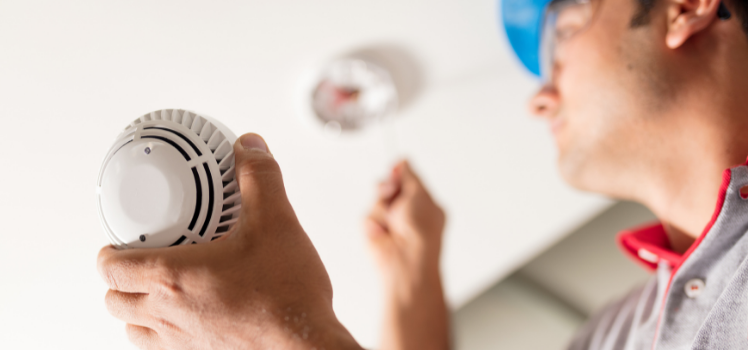As a landlord, you have a duty of care to your tenants that you must fulfil. Within this duty of care, you have a legal responsibility to ensure that your property is safe from dangers of fire and that all landlord fire safety regulations are adequately met.
In this article, we’ll cover what legislation you need to be aware of, what fire hazards could be putting your property at risk and what you must do to keep your tenants safe.
- What fire regulations do landlords need to meet?
- Do landlords need to carry out a fire risk assessment?
- Landlord fire safety regulations and smoke alarms
- Fire-proofing your furniture
- Landlord fire safety regulations: gas safety
- Fire and electrical safety inspections
- Fire safety and carbon monoxide detectors
What fire safety regulations do landlords need to meet?
There are a number of laws and regulations that directly impact your responsibilities as a landlord, including:
- The Housing Act 2004
- The Smoke and Carbon Monoxide Alarm (England) Regulations 2015
- Furniture and Furnishing (Fire Safety) Regulations 1988
- The Regulatory Reform (Fire Safety) Order (2005)
General fire safety in your rental
The Housing Act 2004 basically covers the general fire safety requirements landlords need to meet. This includes making sure that no fire hazards are placed where fires may start, such as tea towels left on hobs, and keeping escape routes clear.
You may be wondering, ‘how am I supposed to make sure the property is always hazard free when I don’t live there?’ Well, the answer is simple: do as much as you reasonably can.
Providing your tenant with relevant fire safety information in writing and asking them to be mindful of escape routes, electrics and keeping combustible objects near fuse boxes or boilers will help to minimise the risk of fire.
Do landlords need to carry out a fire risk assessment?
Of course, warning your tenants of the potential dangers of fire may only get you so far. The best way to ensure your property is fire-safe is to conduct a fire risk assessment.
A fire risk assessment is not a legal requirement for standard private rentals, although, it will provide you with an extra level of compliance and reassurance.
Under The Regulatory Reform (Fire Safety) Order 2005, HMOs with shared communal areas must have a fire risk assessment.
A risk assessment should be carried out every 6 months – and definitely before a new tenant moves in. The risk assessment should contain:
- A
list of potential fire hazards at the property (anything that produce a spark
or flame) - A
list of the people at risk (including neighbouring residents) - An
evaluation of the risks of fire and injury - Methods
of mitigation, protection and prevention - Removal
of hazards - A
record of major issues - An
emergency evacuation plan
If carried out, a fire risk assessment should be overseen by a ‘competent person’. Some landlords may feel comfortable conducting this themselves, but the best way to ensure complete compliance is to book an inspection with your local fire service.
Fire safety property visits
Landlords and letting agents must give tenants at least 24 hours’ written notice before they or anyone under their instruction visits their rental property.
Tenants must give permission for them to enter the property, the only exception being a serious emergency, such as a fire. In this circumstance, the landlord or agent are allowed to take reasonable action and enter the property without permission from the tenant.
Landlord fire safety regulations: smoke alarms
The Smoke and Carbon Monoxide Alarm (England) Regulations 2015 state that all properties in the private rented sector must have a smoke detector on each storey with a room used as living accommodation. All smoke alarms must be in working order at the start of the tenancy.
It was formerly the tenant’s responsibility to ensure smoke alarms are working after the initial test, but the amended regulations commencing 1 October state that landlords are responsible for the repair and replacement of alarms. Tenants are still responsible for informing the landlord, and should go ahead and replace batteries if they can, but the landlord is ultimately responsible for the repair and upkeep during the tenancy.
Although landlords are responsible for providing smoke alarms, the tenant is responsible for making sure they continue to work after the initial test.
Some rental properties will also require a carbon monoxide detector: read more here.
Smoke detectors and fire alarms are tested during professional property inventories, mid-term inspections and check-outs. Organise your property inspection here.
Furnishings and landlord fire safety regulations
In any household, fire is a risk – but the risk is far greater if the furniture is easily flammable. The Furniture and Furnishings (Fire Safety) Regulations 1988 protect upholstered furnishings against fire, covering:
- Beds,
headboards, mattresses and bed-bases - Sofa
beds and futons - Sofas,
armchairs and footstools - Nursery
furniture - Garden
furniture suitable for use indoors (not parasols or deckchairs) - Scatter
cushions, pillows and seat pads - Padded
seats - Loose
and stretch furniture covers
Under the regulations, any of the above furniture that a landlord provides in their rental property must:
- Have
a fire-resistant filling - Be
able to pass a match-resistant test or be fitted with a fire-resistant cover - Be
able to pass a cigarette resistance test - (if
new) be labelled with a fire safety warning
These tests mean that the item will not burst into flame from contact with a match or cigarette.
The regulations don’t cover:
- Beds
(including mattress protectors and duvets) - Curtains
- Carpets
- Furniture
made before 1950
Is a landlord responsible for their tenant’s furnishings?
A landlord is not liable for any furnishings or items supplied by the tenant. Items of furniture, appliances, clothes, décor and anything else a tenant brings with them is their responsibility.
This being said, providing your tenant with some fire safety information can do no harm.
Landlord fire safety regulations: electricals
As a landlord, ensuring the electrics in your property are safe should be a top priority. In 2017/2018, over half of accidental domestic fires in England had an electric origin – 71% of which were started by appliances.
To make sure that your electrics are not a fire hazard, you should carry out an Electrical Installation Condition Report (EICR) every five years. This involves a qualified engineer inspecting the installations in your home for any signs of deterioration, damage or potential danger.
As of April 2020, electrical safety inspections are mandatory for all landlords. Find out what you need to do here. Any portable appliances that you provide your tenant with should also be annually tested for faults. Book your PAT test today for £89 (inc VAT).
Landlord fire safety regulations: gas safety
Ill-fitted or damaged gas appliances can be a serious risk of explosions and fires.
Any gas appliance or fitting that you supply to your property must be in safe condition and inspected by a qualified engineer. It is a legal requirement for all private rental properties to have an annual gas safety inspection and a valid Gas Safety Certificate. Remember – you must provide your tenant with a certificate at the start of their tenancy, or within 28 days of the annual inspection.
Without a valid Gas Safety Certificate, not only will you be neglecting your duty of care for your tenant, but you will also be unable issue a Section 21 notice if needed.
Landlords that aren’t compliant with gas safety regulations can be subject to financial penalties, fines and – in severe circumstances – serious criminal charges.
Book your gas safety inspection today for just £79 (inc VAT).
Landlord fire safety regulations: fire doors
If your property is an HMO, you must have certified fire doors.
If properly installed, fire doors can be extremely effective in improving fire safety within your rental property. All fire doors come with an ‘FD’ rating which measures how many minutes the door can resist fire. Find out more about fire doors in our other article: Fire Door Safety in Rental Properties.
Landlord fire safety regulations: carbon monoxide detectors
Fires and explosions aren’t the only dangers presented by faulty gas fittings. Damaged or broken gas appliances, pipes or flues can also lead to carbon monoxide poisoning.
Carbon monoxide (CO) is a poisonous colourless gas produced by incomplete burning of carbon-based fuels – such as gas, oil or wood. CO is only produced when the fuel doesn’t burn properly – so if your gas boiler or stove isn’t working correctly, you could be putting your tenants at serious risk.
In private rentals, carbon monoxide detectors are a legal requirement in any room containing a solid-fuel appliance – such as a wood burning stove or working open fire. Whilst it’s not the law, it’s also best practice to have a carbon monoxide detector in any room with a gas appliance.
Stay on top of all landlord legislative updates with by signing up to our newsletter.



